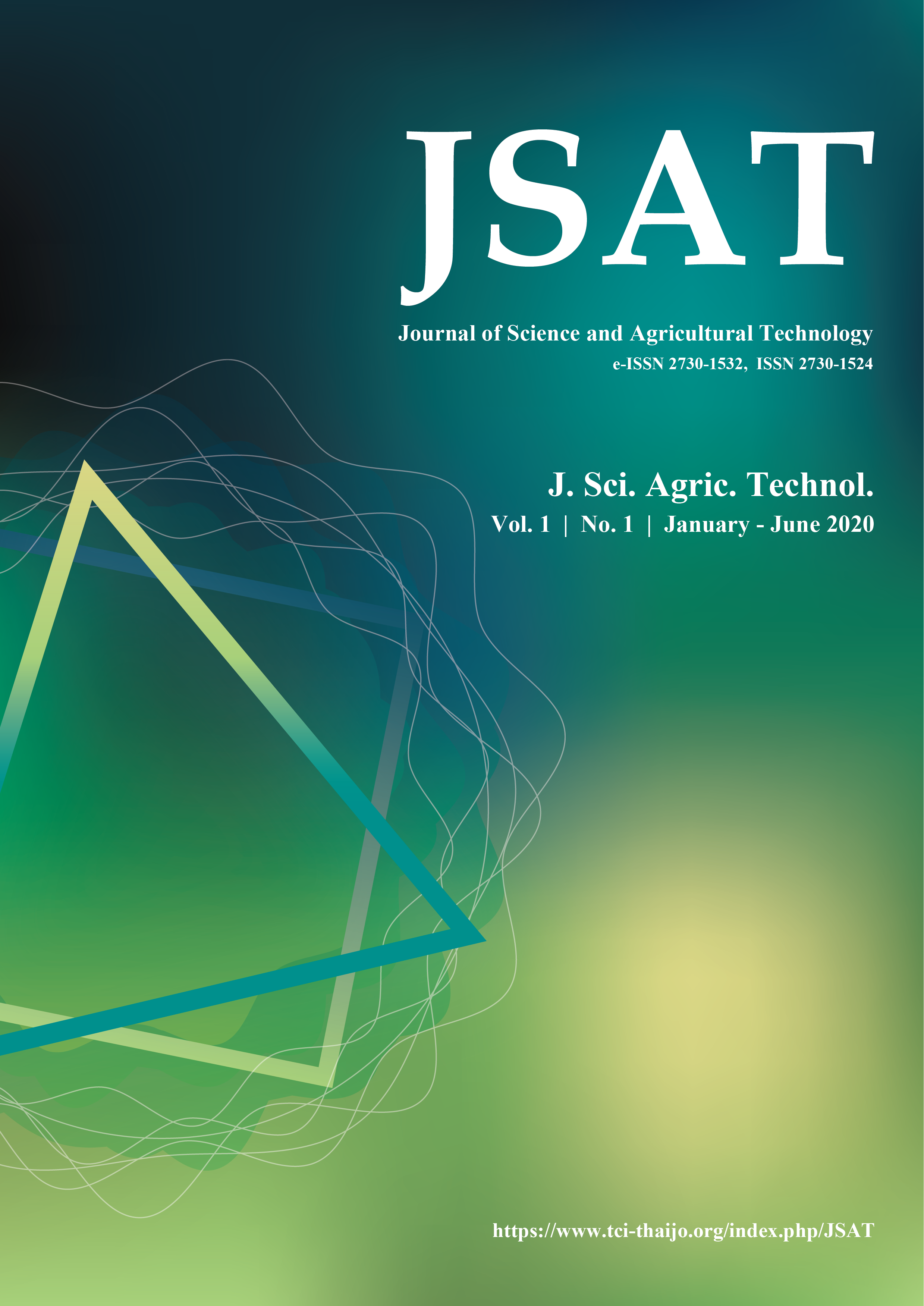Preparation of activated carbon as support of nickel catalyst for Guerbet reaction
Main Article Content
Abstract
This work aims to prepare activated carbon from charcoal of the wood of M. calabura and employ as a support for nickel catalyst. The charcoal was obtained from an Iwasaki kiln and activated by CO2. Then, the surface of activated carbon was modified by air zero to create acid functional groups. The polyaromatic-like structure and their functional groups of the activated carbon were characterized by FTIR and CHNO analysis. The thermal stability was carried out by TGA analysis. The surface area of sample was estimated by BET from N2 adsorption-desorption analysis. The activated carbon after modification had higher acid functional groups than the parent charcoal. The BET surface area decreased after modification but the thermal stability did not change after CO2 treatment. After impregnated with nickel precursor, the structure, acidity and basicity of the catalyst were analyzed by XRD, NH3-TPD and CO2-TPD, respectively. Nickel nanoparticles were produced on activated carbon. The catalytic screening of Guerbet reaction to produce n-butanol from ethanol conversion was performed under autogeneous pressure at 240 °C for 6 h. The nickel supported on activated carbon showed higher ethanol conversion than the unsupported nickel nanoparticles.
Article Details
References
Aboud, M.F.A., ALOthman, Z.A., Habila, M.A., Zlotea, C., Latroche, M. and Cuevas, F. 2015. Hydrogen storage in pristine and d10-block metal-anchored activated carbon made from local wastes. Energies. 8: 3578 – 3590.
Azzi Rios, R.R.V., Alves, D.E., Dalmázio, I., Bento, S.F.V., Donnici, C.L. and Lago, R.M. 2003. Tailoring Activated Carbon by Surface Chemical Modification with O, S, and N Containing Molecules. Materials Research. 6(2): 129 – 135.
Dharmaraj, N., Prabu, P., Nagarajan, S., Kim, C.H., Park, J.H. and Kim, H.Y. 2006. Synthesis of nickel oxide nanoparticles using nickel acetate and poly(vinyl acetate) precursor. Materials Science and Engineering: B. 128(1-3): 111 – 114.
Fidalgo, B., Zubizarreta, L., Bermúdez, J.M., Arenillas, A. and Menéndez, J.A. 2010. Synthesis of carbon-supported nickel catalysts for the dry reforming of CH4. Fuel Processing Technology. 91: 765 – 769.
Hesas, R.H., Arami-Niya, A., Daud, W.M.A.W. and Sahu, J.N. 2013. Preparation and characterization of activated carbon from apple waste by microwave-assisted phosphoric acid activation: application in methylene blue adsorption. BioResources. 8(2): 2950 – 2966.
Jordison, T.L., Lira, C.T. and Miller D.J. 2015. Condensed-phase ethanol conversion to higher alcohols. Industrial & Engineering Chemistry Research. 45: 10991 – 11000.
Junpirom, S., Tangsathitkulchai, C. and Tangsathitkulchai, M. 2007. Preparation of activated carbons from longan seed by physical and chemical methods (in Thai). Suranaree Journal of Science and Technology. 14(1): 63 – 76.
Kamiński, W., Tomczak, E. and Górak, A. 2011. Biobutanol - production and purification methods. Ecological Chemistry and Engineering S. 18: 31 – 37.
Motuzas, J., Drobek, M., Diniz da Costa, J.C. and Julbe, A. 2014. Novel microwave assisted approach to large scale nickel nanoparticle fabrication. Chemical Engineering Journal. 240: 155 – 160.
Ndou, A.S., Plint, N. and Coville, N.J. 2003. Dimerisation of ethanol to butanol over solid-base catalysts. Applied Catalysis A: General. 251: 337 – 345.
Ngernyen, Y., Tangsathitkulchai, C. and Tangsathitkulchai, M. 2005. The modification of acidic surface functionality of wood-based activated carbon. Suranaree Journal of Science and Technology.
Peng, G., Steib, M., Gramm, F., Ludwig, C. and Vogel, F. 2014. Synthesis factors affecting the catalytic performance and stability of Ru/C catalysts for supercritical water gasification. Catalysis Science & Technology. 4(9): 3329 – 3339.
Riittonen, T., Eränen, K., Mäki-Arvela, P., Shchukarev, A., Rautio, A.-R., Kordas, K., Kumar, N., Salmi, T. and Mikkola, J. 2015. Continuous liquid-phase valorization of bio-ethanol towards bio-butanol over metal modified alumina. Renewable Energy. 74: 369 – 378.
Riittonen, T., Toukoniitty, E., Madnani, D.K., Leino, A.-R., Kordas, K., Szabo, M., Sapi, A., Arve, K., Wärnå, J. and Mikkola, J.-P. 2012. One-pot liquid-phase catalytic conversion of ethanol to 1-butanol over aluminium oxide - the effect of the active metal on the selectivity. Catalysts. 2: 68 – 84.
Rios, R.R.A., Alves, D.E., Fernando, D.S., Bento, V., Donnici, L. and Lago, R.M. 2003. Tailoring Activated Carbon by Surface Chemical Modification with O, S, and N Containing Molecules. Material research. 6: 129 – 135.
Vasu, A.E. 2008. Surface Modification of Activated Carbon for Enhancement of Nickel(II) Adsorption. E-Journal of Chemistry. 5(4): 814 – 819.
Wojcieszak, R., Zieliński, M. and Bettahar, M.M. 2006. Study of nickel nanoparticles supported on activated carbon prepared by aqueous hydrazine reduction. Journal of Colloid Interface Science. 299(1): 238 – 248.
Yao, S., Yang, C., Tan, Y. and Han, Y. 2008. Deactivation and regeneration of an activated carbon-supported nickel catalyst for methanol carbonylation in the vapor phase. Catalysis Communications. 9(11–12): 2107 – 2111.
Zhang, F., Chen, Y., Zhao, J. and Li, H. 2004. Preparation of Nanosized Nickel Particles by Hydrothermal Method. Chemistry Letters. 33(2): 146 – 147.
Zhang, X., Liu, Z., Xu, X., Yue, H., Tian, G. and Feng, S. 2013. Hydrothermal synthesis of 1-butanol from ethanol catalyzed with commercial cobalt powder. ACS Sustainable Chemistry & Engineering. 1: 1493 – 1497.


